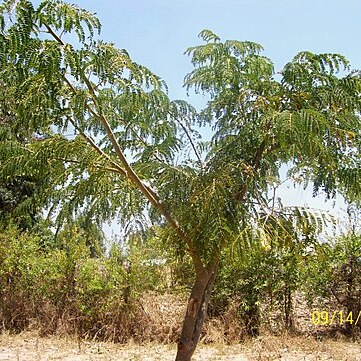Leaves: rhachis shortly and densely to sparsely pubescent; pinnae (1)2-7 pairs; leaflets of the 2 distal pairs of pinnae 6-21(23) pairs (sometimes as few as 5 pairs on the lower pinnae), 7-21(30) x 3·5-8·5(16) mm., variable in shape and size, obliquely oblong, or rhombic to falcate-oblong, acute to rounded and mucronate at the apex, which is turned towards the pinna-apex, with diagonal midrib, ± appressed-pubescent beneath and often with the lower surface paler than the upper or even whitish when dry, glabrescent above.
A tree. It grows 30-40 m high. It loses its leaves for a month. The trunk is straight. The flat crown can be 30 m across. Three varieties are recognised. The bark may be poisonous. The leaves have 4-7 pairs of leaflet stalks with 6-22 pairs of leaflets. They are unevenly oblong. They are often hairy and more pale underneath. The flowers are in loose heads. They are creamy-white. The fruit are flattened pods up to 34 cm long. They are brown.
Tree 5-23(30) m. high; crown flat or not; bark smooth, grey or sometimes brownish and rough; young branchlets densely, or sometimes sparsely, and shortly brown-pubescent (sometimes pubescence grey but not in our area), later glabrescent.
Flowers white or pale-yellow, pedicellate; pedicels 2-6 mm. long, densely and shortly brown-(in our area) pubescent or sometimes puberulous, as are the calyces and corollas.
Pod apparently indehiscent, 15-34 x (2)2·8-5·9 cm., oblong, puberulous (sometimes sparsely so), not glossy, venose, brown.
Staminal tube not or scarcely exserted beyond the corolla; filaments c. 0·7-1·2 cm. long.
Calyx 1·5-2·5 mm. long, not slit unilaterally.
Seeds 9-11 x 6·5-8 mm., flattened.
Corolla 4-7·5 mm. long.


